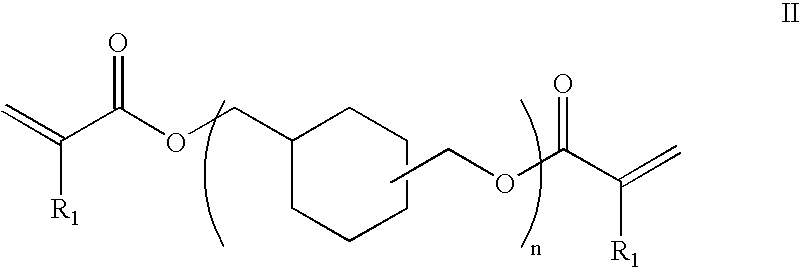Thermosetting polyether oligomers, compostions and methods for use thereof
a technology of polyether oligomers and compositions, applied in the direction of non-conductive materials with dispersed conductive materials, inks, synthetic resin layered products, etc., can solve the problems of limited range of (meth)acrylate monomers, currently available, polypropylene oxide derivatives, etc., and achieve the effect of low viscosity
- Summary
- Abstract
- Description
- Claims
- Application Information
AI Technical Summary
Benefits of technology
Problems solved by technology
Method used
Image
Examples
example 1
Preparation of an Oligomer of Structural Formula II
[0142]A single-neck, 500 mL flask was charged with 86.52 g (0.6 mole) Unoxol Diol (a blend of 1,4- and 1,3-cyclohexanedimethanol isomers from Dow Chemical), 40 mL heptane and 1.0 g methanesulfonic acid and a magnetic stir bar. A Dean-Stark trap and condenser were attached. This mixture was refluxed for eighteen hours, under an argon blanket, to collect 9.2 mLs water. The mixture was cooled and 200 mL heptane, 16.2 g (0.225 mole) acrylic acid, 19.4 g (0.225 mole) methacrylic acid, and 210 mg hydroquinone were added. The new mixture was stirred under an air sparge for 3.5 hours and another 5.4 mL of water was collected. The flask was then cooled again and the mixture was placed in a sepratory funnel and extracted with five, twenty-five mL portions of deionized water. The heptane phase was then neutralized with 20 g sodium bicarbonate, dried with 12 g magnesium sulfate and then passed over 30 g silica gel. The heptane was removed to ob...
example 2
Preparation of an Oligomer of Structural Formula II at Controlled Temperature
[0143]The procedure of Example 1 was repeated, except that the first (etherification) step was controlled at 160° C. The water collected in the first step was 9.0 mL. The water collected in the second step was 6.2 mL. The recovered product was a clear, light orange, liquid that weighed 72.6 g (75.0% of theoretical yield). The 5 rpm viscosity at 25.0° C. was 264 centipoises. The FTIR trace was virtually identical to that observed in Example 1. The residual weight via TGA for this monomer was 90.2% and 96.9% for the neat and catalyzed (2% dicumyl peroxide) samples at 300° C., respectively. A DSC run on this compound had an onset temperature at 138.6° C., a cure maxima at 148.4° C., and a cure energy of 247.5 joules per gram. A GPC was run on this product and it was found to consist of a mixture of approximately 28.6% mono (n=1), 26.2% di-(n=2), 17.0% tri-(n=3), and 20.1% tetra-(n=4) compounds according to Str...
example 3
Preparation of an Oligomer of Structural Formula II with Increased Catalyst
[0144]The procedure of Examples 1 and 2 was repeated, except that the quantity of methanesulfonic acid catalyst was increased from 1.0 to 10.0 grams, and the first (etherification) step was controlled at 145-155° C. The water collected in the first step was 9.2 mL. The water collected in the second step was 7.2 mL. The recovered product was a clear, light orange, liquid that weighed 76.1 g (75.0% of theoretical yield). The 5 rpm viscosity at 25.0° C. was 149 centipoises. The FTIR trace was virtually identical to that of Examples 1 and 2. The residual weight via TGA for this polyether was 79.2% and 93.1% for the neat and catalyzed (2% dicumyl peroxide) samples at 300° C., respectively. A DSC run on the catalyzed compound had an onset temperature at 140.3° C., a cure maxima at 152.1° C., and a cure energy of 270.9 joules per gram. A GPC was run on this product and it was found to consist of a mixture of approxi...
PUM
| Property | Measurement | Unit |
|---|---|---|
| Percent by mass | aaaaa | aaaaa |
| Electrical conductivity | aaaaa | aaaaa |
| Viscosity | aaaaa | aaaaa |
Abstract
Description
Claims
Application Information
 Login to View More
Login to View More - R&D
- Intellectual Property
- Life Sciences
- Materials
- Tech Scout
- Unparalleled Data Quality
- Higher Quality Content
- 60% Fewer Hallucinations
Browse by: Latest US Patents, China's latest patents, Technical Efficacy Thesaurus, Application Domain, Technology Topic, Popular Technical Reports.
© 2025 PatSnap. All rights reserved.Legal|Privacy policy|Modern Slavery Act Transparency Statement|Sitemap|About US| Contact US: help@patsnap.com



